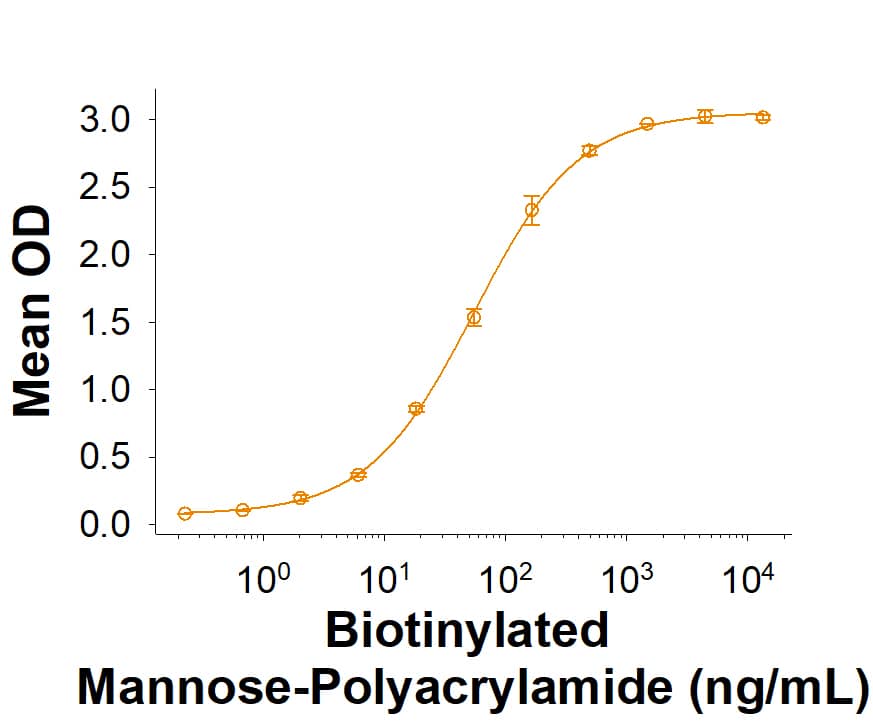Recombinant Human Langerin/CD207 Fc Chimera Protein, CF
R&D Systems, part of Bio-Techne | Catalog # 10401-LN

Key Product Details
Source
CHO
Accession #
Structure / Form
Disulfide-linked homodimer
Conjugate
Unconjugated
Applications
Bioactivity
Product Specifications
Source
Chinese Hamster Ovary cell line, CHO-derived human Langerin/CD207 protein
| MD | Human IgG1 (Pro100-Lys330) |
IEGR | Human Langerin/CD207 (Pro65-Pro328) Accession # Q9UJ71.2 |
| N-terminus | C-terminus | ||
Purity
>95%, by SDS-PAGE visualized with Silver Staining and quantitative densitometry by Coomassie® Blue Staining.
Endotoxin Level
<0.10 EU per 1 μg of the protein by the LAL method.
N-terminal Sequence Analysis
Met
Predicted Molecular Mass
56 kDa
SDS-PAGE
58-71 kDa, under reducing conditions
Activity
Measured by its binding ability in a functional ELISA.
When Recombinant Human Langerin/CD207 Fc Chimera (Catalog # 10401-LN) is immobilized at 0.2 µg/mL (100 µL/well), Biotinylated Mannose-Polyacrylamide binds with an ED50 of 20-160 ng/mL.
When Recombinant Human Langerin/CD207 Fc Chimera (Catalog # 10401-LN) is immobilized at 0.2 µg/mL (100 µL/well), Biotinylated Mannose-Polyacrylamide binds with an ED50 of 20-160 ng/mL.
Scientific Data Images for Recombinant Human Langerin/CD207 Fc Chimera Protein, CF
Recombinant Human Langerin/CD207 Fc Chimera Protein Binding Activity
When Recombinant Human Langerin/CD207 Fc Chimera (10401-LN) is immobilized at 0.2 μg/mL (100 μL/well), Biotinylated Mannose-Polyacrylamide binds with an ED50 of 20-160 ng/mL.Recombinant Human Langerin/CD207 Fc Chimera Protein SDS-PAGE
2 μg/lane of Recombinant Human Langerin/CD207 Fc Chimera (Catalog # 10401-LN) was resolved with SDS-PAGE under reducing (R) and non-reducing (NR) conditions and visualized by Coomassie® Blue staining, showing bands at 58-71 kDa and 116-142 kDa, respectively.Formulation, Preparation and Storage
10401-LN
| Formulation | Lyophilized from a 0.2 μm filtered solution in PBS and NaCl with Trehalose. |
| Reconstitution | Reconstitute at 500 μg/mL in PBS. |
| Shipping | The product is shipped at ambient temperature. Upon receipt, store it immediately at the temperature recommended below. |
| Stability & Storage | Use a manual defrost freezer and avoid repeated freeze-thaw cycles.
|
Background: Langerin/CD207
References
- Valladeau, J. et al. (2000) Immunity 12:71.
- Valladeau, J. et al. (2003) Immunol. Res. 28:93.
- McDermott, R. et al. (2002) Mol. Biol. Cell 13:317.
- Stambach, N. S. and M. E. Taylor (2003) Glycobiology 13:401.
- Tada, Y. et al. (2006) J. Invest. Dermatol. 126:1549.
- Ritter, U. and A. Osterloh (2007) Med. Microbiol. Immunol. 196:51.
- Takahara, K. et al. (2003) Int. Immunol. 16:819.
- Hunger, R. E. et al. (2004) J. Clin. Invest. 113:701.
- De Witte, L. et al. (2007) Nat. Med. 13:367.
- Verdijk, P. et al. (2005) J. Invest. Dermatol. 124:714.
- Ward, E. M. et al. (2006) J. Biol. Chem. 281:15450.
- Kissenpfennig, A. et al. (2005) Mol. Cell. Biol. 25:88.
Alternate Names
CD207
Gene Symbol
CD207
UniProt
Additional Langerin/CD207 Products
Product Documents for Recombinant Human Langerin/CD207 Fc Chimera Protein, CF
Product Specific Notices for Recombinant Human Langerin/CD207 Fc Chimera Protein, CF
For research use only
